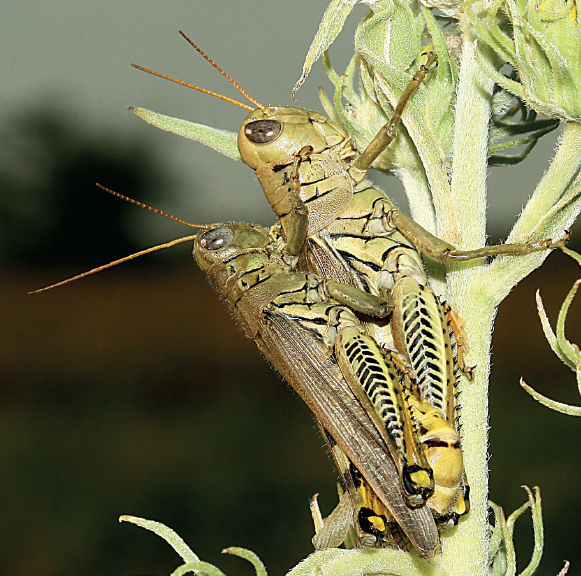
(A) grasshoppers (Insecta)
INTRODUCTION TO GARDEN INSECTS AND THEIR RELATIVES
WITH FEW EXCEPTIONS, the animals covered in this book are all classified as members of the phylum Arthropoda—the arthropods. As such, all share certain physical features, including:
— division of the body into segments;
— an external skeleton (exoskeleton) and growth that requires periodic shedding of the exoskeleton (molting);
— jointed appendages;
— internal structures that include a heart running along the upper (dorsal) part of the body and a nerve cord running along the lower (ventral) part of the body; and
— symmetrical construction of both sides of the animal (bilateral symmetry).
In the manner in which all life forms are organized and classified, the primary subdivisions of a phylum, such as Arthropoda, are known as classes. Although this book concerns itself primarily with the class Insecta, the insects, representatives of six other arthropod classes may be found in yards and gardens: springtails, arachnids, millipedes, centipedes, symphylans, and some land-adapted crustaceans (e.g., sowbugs, pillbugs).
There are a few additional groups of animals included in this book, notably the slugs and snails. These are mollusks, phylum Mollusca, more closely related to clams and mussels than insects, but often perceived as being “garden bugs” and may produce injuries similar to those of many insects. Two other phyla are given a bit of attention in chapter 6, the segmented worms, phylum Annelida, which includes earthworms, and the flatworms, phylum Platyhelminthes.
The classification of the animals described in this book, to the order level, is summarized as follows:
Phylum ARTHOPODA Arthropods
Class MALACOSTRACA
Order Isopoda Pillbugs and Sowbugs
Order Decapoda Crayfish, Shrimp
Order Amphipoda Amphipods
Class DIPLOPODA Millipedes
Order Julida
Order Spirobolida
Order Polydesmida Flat-backed millipedes
Order Polyxenida Bristly millipedes
Class CHILOPODA Centipedes
Order Lithobiomorpha Stone centipedes
Order Scolopendromorpha Bark centipedes
Order Geophilomorpha Soil centipedes
Order Scutigeridae House centipedes
Class SYMPHYLA Symphylans
Order Scutigerellidae Symphylans
Class ARACHNIDA Arachnids
Order Opiliones Daddy longlegs, Harvestmen
Order Araneae Spiders
Order Acari Mites and Ticks
Class COLLEMBOLA Springtails
Class INSECTA Insects
Phylum MOLLUSCA Mollusks
Class GASTROPODA Gastropods
Clade: Stylommatophora Slugs and Snails
Phylum ANNELIDA Segmented Worms
Class CLITELLATA Leeches and Earthworms
Subclass Oligochaeta Earthworms
Phylum PLATYHELMINTHES Flatworms, Flukes, Tapeworms
Class TERBELLARIA Free-living Flatworms
Representatives of the seven classes of arthropods that may be found in yard and garden:

(A) grasshoppers (Insecta)
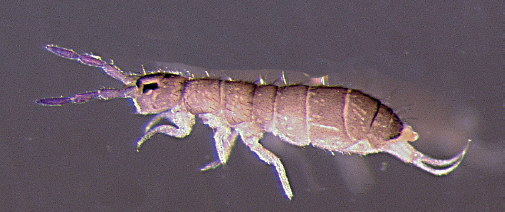
(B) springtails (Collembola)
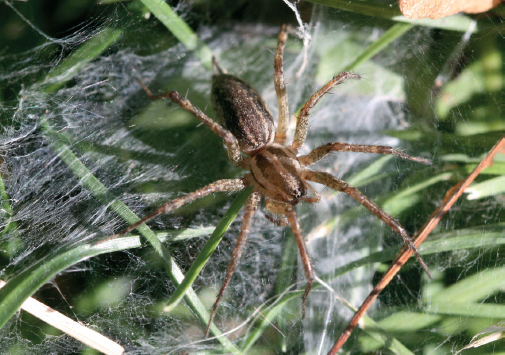
(C) spiders (Arachnida)

(D) garden symphylans (Symphyla)
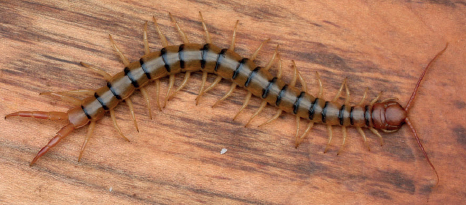
(E) centipedes (Chilopoda)
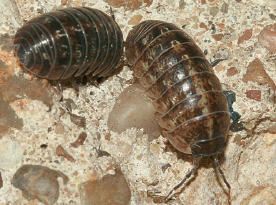
(F) isopods (Malacostraca)
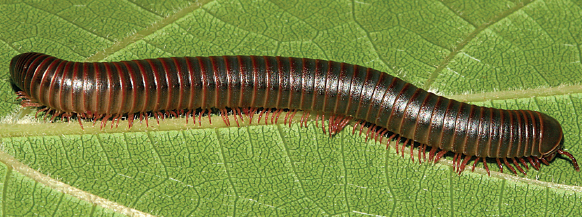
(G) millipedes (Diplopoda).
Representatives of Nonarthropods found in yards and gardens:
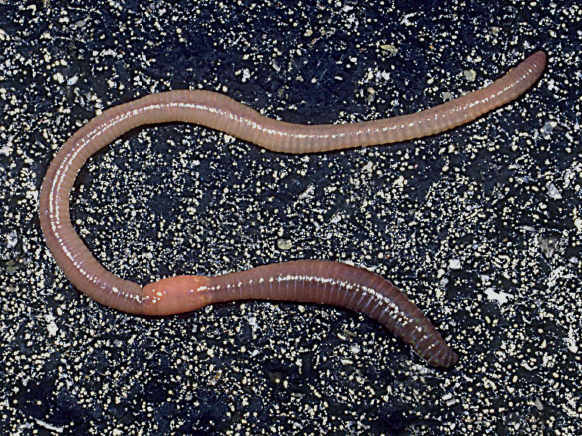
(H) earthworms (phylum Annelida)
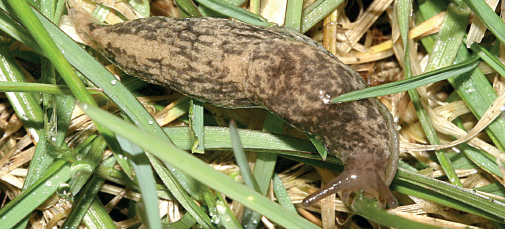
(I) slugs (phylum Mollusca)
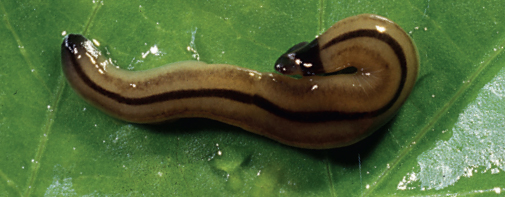
(J) land planarians (phylum Platyhelminthes).
ARTHROPOD GROWTH AND METAMORPHOSIS
Because arthropods possess an external skeleton, which confines their size, in order to grow they must periodically shed the exoskeleton, building a new, larger one at the same time. This process is called molting and all arthropods must molt repeatedly during their lifetime. As a result of this type of development, arthropod growth occurs in a series of distinct stages, each punctuated by a molting event. The term instar is used to describe each of the stages in a developing arthropod; insects typically pass through three to seven instars as they develop. The ultimate stage is the sexually mature adult.
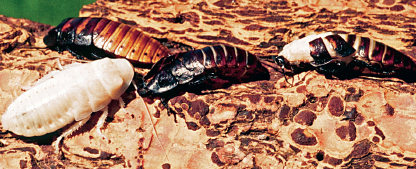
Cockroaches in stages of molting. The individual on the right is in the process of shedding the remnants of the previous exoskeleton. The pale color of the cockroaches to the left and right is the new exoskeleton, which has not undergone the process of hardening and darkening that makes up the final stage during molting. WHITNEY CRANSHAW
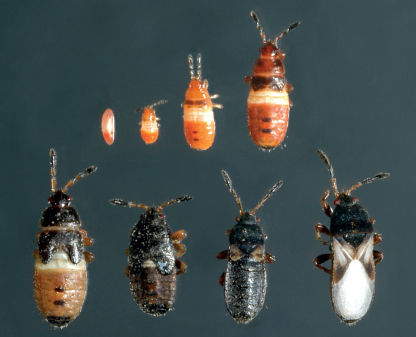
Life stages of a chinch bug, a type of insect with simple metamorphosis. On the top row is the egg, followed by three stages (instars) of nymphs. On the bottom row are different adult forms. JIM KALISCH, UNIVERSITY OF NEBRASKA
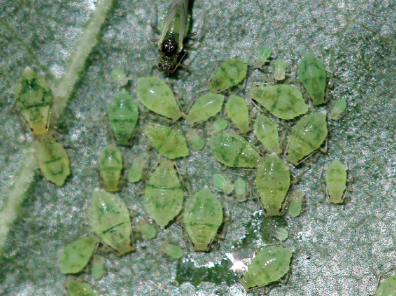
Adults (winged and wingless forms) and nymphs of an aphid. WHITNEY CRANSHAW
During this growth process, arthropods will not only progressively increase in size but usually also undergo some changes in form, a process known as metamorphosis. Sometimes these changes are minor, perhaps involving small differences in body shape, coloration, or patterning. In others there can be dramatic differences in appearance during different stages in their development.
Broadly speaking, among the insects, one of two general patterns of metamorphosis is followed: simple metamorphosis or complete metamorphosis. Earwigs, grasshoppers, and aphids are examples of those that have a simple type of metamorphosis. They have immature stages, known as nymphs, that generally resemble the adult in overall appearance, feed in the same manner, and occur in the same environments. In addition to a change in size, the nymphs may develop external features, such as wing pads, that become increasingly prominent in later instars. Adult insects differ from nymphs by being sexually mature and, if they are winged, having functional wings. Much more specialization of function—and difference in form—occur among the insects that undergo complete metamorphosis. The immature stages are collectively known as larvae, although larvae of many insects are so recognizable that they may be referred to by a common name such as grub, caterpillar, or maggot. Immature forms are often similar in appearance, progressively increasing in size with each instar. Following is transition to a unique stage known as the pupa. Tremendous changes take place during the pupal stage as larval features disappear and transition to features unique to the adult—the transformation of a caterpillar to a butterfly being one of the best recognized examples. Among insects with complete metamorphosis, the appearance and habits of the adult may be very different from those of larvae. The overwhelming number of insect species are those that undergo complete metamorphosis and include beetles, moths and butterflies, flies, bees, ants, and wasps.
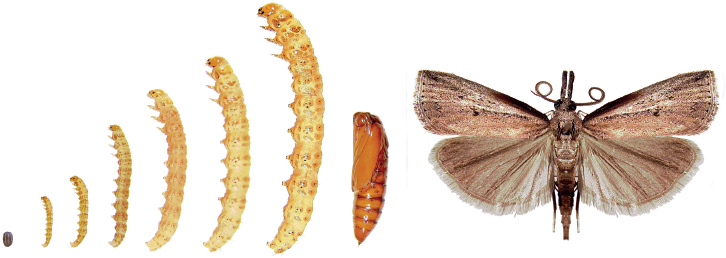
Life stages of a sod webworm, a type of insect with complete metamorphosis. Stages include (left–right) egg, six stages (instars) of larvae, pupa, adult. DAVID SHETLAR
Life stages of a lady beetle:
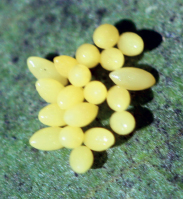
(A) eggs
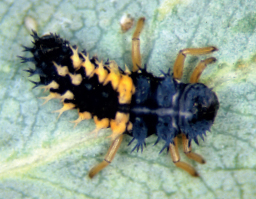
(B) larva
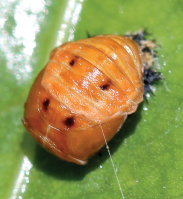
(C) pupa
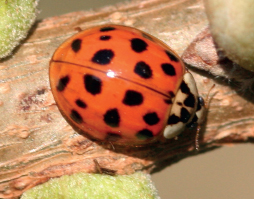
(D) adult, WHITNEY CRANSHAW
Regardless of the type of metamorphosis, further development of external structures ceases once insects molt to their ultimate adult form. Therefore a little fly is not a “baby” big fly nor is a tiny ant a “baby” ant. They are merely adults of a small species or individuals that were stressed through poor diet or some other factor that suppressed development in their immature stages.
There are variations in this development pattern among some insects and the noninsect arthropods. Springtails and insects that evolved before the development of wings, such as silverfish (order Thysanura), show little change in form as they grow, but gradually increase in size and become sexually mature in the ultimate stages. Most arachnids (spiders, mites, scorpions, and the like) have a development pattern similar to simple metamorphosis. However, among the mites and ticks, the first-instar nymphs that emerge from eggs have only six legs, obtaining their full complement of eight legs only after the next molt (second instar). Among all millipedes and many centipedes, additional leg-bearing segments will be added during some molts, resulting in a type of growth known as anamorphic development.
Several features separate insects from the other arthropod classes. These include:
— division of the body into three main regions (head, thorax, abdomen);
— three pairs of legs, located on the thorax; and
— one pair of antennae.
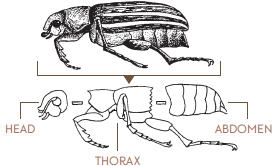
FIGURE 1. Body regions of an adult insect.

FIGURE 2. Body regions of two insect larvae.
FIGURES BY MATT LEATHERMAN
Many insects also develop wings in the adult stage and thus are the only winged arthropods.
Currently, about 30 orders of insects are recognized. Several are infrequently, if ever, encountered in North American yards and gardens because of their small size, scarcity, or habits that restrict them to different environments. The orders and types of metamorphosis of the insects most likely to be seen in yards and gardens include:
ORDER (COMMON NAME) |
TYPE OF METAMORPHOSIS |
Coleoptera (beetles) |
Complete |
Diptera (flies, gnats, mosquitoes, and relatives) |
Complete |
Lepidoptera (butterflies, moths, skippers) |
Complete |
Hymenoptera (ants, bees, wasps, sawflies, and relatives) |
Complete |
Neuroptera (lacewings, antlions, and relatives) |
Complete |
Thysanoptera (thrips) |
Variation on simple metamorphosis including nonfeeding stages prior to adult emergence |
Odonata (damselflies and dragonflies) |
Simple, but immature form lives in water and has substantial physical differences from adult form |
Orthoptera (grasshoppers, crickets, katydids) |
Simple |
Mantodea (mantids) |
Simple |
Phasmatodea (walkingsticks) |
Simple |
Blattodea (cockroaches and termites) |
Simple. The social species (termites) produce different forms/castes (reproductive females, reproductive males, soldiers, workers). Termite workers may remain in immature form for life, but can differentiate to specialized adult forms with colony needs. |
Dermaptera (earwigs) |
Simple |
Hemiptera (true bugs, aphids, psyllids, whiteflies, etc.) |
Simple, but some species have nonfeeding stages that share features intermediate with complete metamorphosis |
IDENTIFICATION OF IMMATURE STAGES OF ARTHROPODS
Because of the changes that occur during development, arthropods change in appearance at different life stages. These changes are particularly dramatic in insects that undergo complete metamorphosis (e.g., beetles, moths and butterflies, bees, ants, wasps, and flies). Often it is the immature stage (e.g., caterpillar, grub) that causes most plant injury, as many larvae are specialized feeding machines. Adults may feed in a very different way and have very different form and functions (e.g., reproduction, dispersal); thus, it can be particularly difficult when observing insects that have complete metamorphosis to associate the adult and immature stages as being the same species.
The arthropod orders with immature stages most likely to be seen in yards and gardens are discussed below.
COLEOPTERA (BEETLES)
Beetle larvae are often known as grubs. All possess strong jaws designed to chew, and the jaws may be quite prominent in species that chew wood or capture prey. Three pairs of legs on the thorax are clearly present among those species that actively move about aboveground or on the surface of plants (e.g., lady beetles, leaf beetles).
Grubs that develop belowground or within plants typically lose pigmentation and are pale colored, usually creamy white. Among those that actively dig in soil, such as the white grubs, the front legs are well developed and may be used in digging. Many important groups of beetles develop within plants, however, and their larvae have lost all legs in the course of evolution, leaving only the darkly colored head capsule as a conspicuous feature. The larvae of bark beetles and weevils somewhat resemble pieces of puffed rice with a dark head. Flatheaded borers, the larvae of metallic wood borers, are quite elongated and have a broad area on the first segment of the thorax. Roundheaded borers, larvae of longhorned beetles, are also quite elongated, with the dark prominent jaws distinguishing the head region.
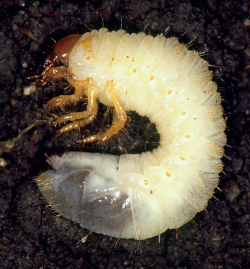
Larva of a scarab beetle, known as a white grub (Coleoptera). JIM KALISCH, UNIVERSITY OF NEBRASKA

Larva of a ground beetle (Coleoptera). WHITNEY CRANSHAW

Larva of a metallic wood borer, known as a flatheaded borer (Coleoptera). WHITNEY CRANSHAW
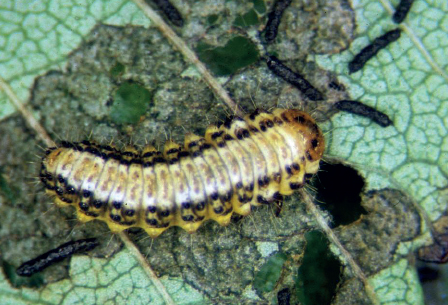
Larva of a leaf beetle (Coleoptera) WHITNEY CRANSHAW
LEPIDOPTERA (BUTTERFLIES, MOTHS, SKIPPERS)
Immature stages of lepidopterans are known as caterpillars. They possess the normal three pairs of true legs on the thorax but, unlike most immature insects, they also possess fleshy leglike extensions, known as prolegs, on several segments of the abdomen. Each proleg is tipped with minute hooks, known as crochets, arranged in patterns characteristic of each family. All lepidopteran caterpillars can be distinguished from other insect larvae by the presence of two to five pairs of prolegs, each of which is tipped with crochets.
The legs and prolegs of caterpillars that bore into plants (e.g., clearwing borers) may be very reduced; however, the presence of crochets always distinguishes them from other wood-boring larvae.
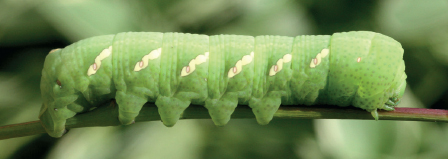
Larva of a sphinx moth (Lepidoptera). WHITNEY CRANSHAW
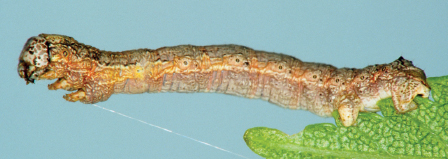
Larva of a geometrid moth, known as a looper or inchworm (Lepidoptera). JIM KALISCH, UNIVERSITY OF NEBRASKA
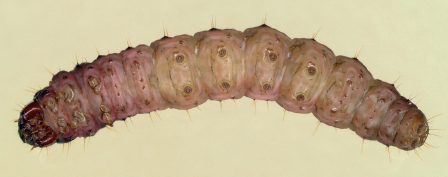
Underside of a caterpillar of the Zimmerman pine moth, showing the prolegs on the abdomen that are tipped with hooks (crochets). JIM KALISCH, UNIVERSITY OF NEBRASKA
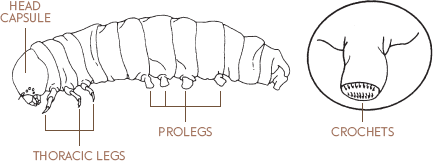
Illustration of the prolegs, tipped with hooks (crochets) that are present on the abdomen of Lepidoptera larvae. FIGURE BY MATT LEATHERMAN
NEUROPTERA (LACEWINGS, ANTLIONS, AND RELATIVES)
All neuropteran larvae are predators. Curved, lancelike jaws project prominently from the head. Larvae possess legs on the thorax but no prolegs on the abdomen.
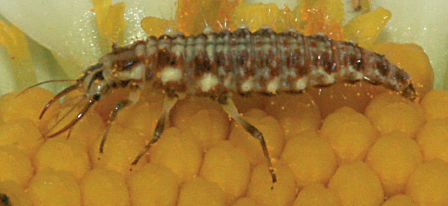
Larvae of a green lacewing (Neuroptera). WHITNEY CRANSHAW
HYMENOPTERA (ANTS, BEES, WASPS, SAWFLIES, AND RELATIVES)
Rarely do gardeners encounter the larval stages of most insects in the order Hymenoptera. This is because they either occur within colonies (e.g., social wasps, honey bees, ants), develop in specialized nest cells (e.g., hunting wasps, leafcutter bees), or are hidden within plants (e.g., gall wasps). These larvae are usually very pale-colored and have little pigmentation except around the mouthparts. A distinct head region is present but can be difficult to distinguish since there is little difference in color to distinguish it from the rest of the body.
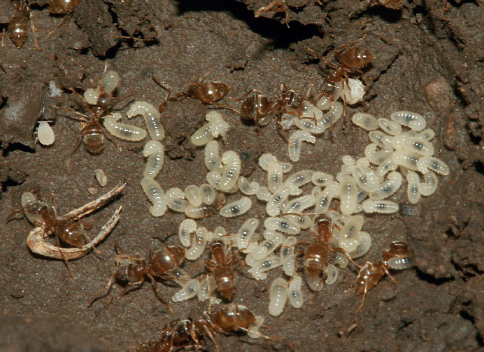
Adult ants tending larvae (Hymenoptera). DAVID SHETLAR
Larval features are very different among some of the active leaf-feeding larvae, notably the sawflies. Sawfly larvae look quite similar to moth and butterfly larvae and similarly are often termed caterpillars. Like Lepidoptera larvae, sawfly larvae have prolegs on the abdomen, but the number is significantly different. Sawflies possess six to eight pairs of prolegs, and none have the hooklike crochets at the tip that characterize moth and butterfly larvae.
DIPTERA (FLIES, GNATS, MOSQUITOES, AND RELATIVES)
Larvae of the “true flies” completely lack legs. Furthermore, many lack any distinct head area. Instead the head end is often tapered to a point and surrounds a pair of tiny hooks that are normally retracted. A pair of eyelike spiracles are commonly present on the hind end. This larval form is known as a maggot and is produced by flies in the suborder Brachycera (e.g., root maggots, house flies, flower flies).
Larvae in the suborder Nematocera (e.g., gnats, midges, mosquitoes) also lack legs but have a distinctly visible head capsule that is often darker than the rest of the body.
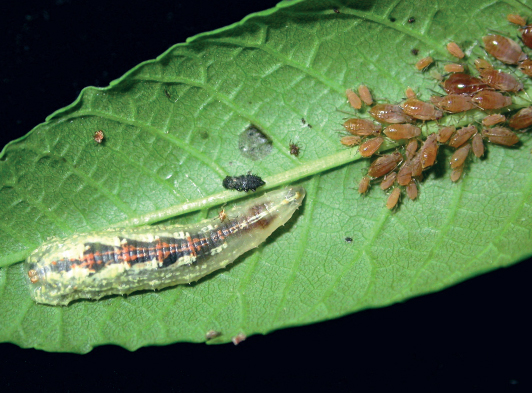
Larva of a syrphid fly (Diptera) with colony of aphids (Hemiptera).
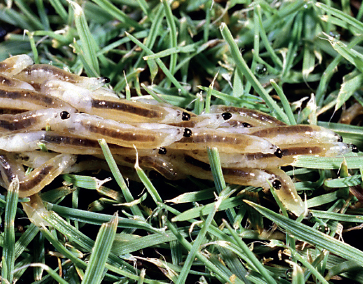
Larvae of fungus gnat (Diptera), massed on lawn. JIM KALISCH, UNIVERSITY OF NEBRASKA
ORTHOPTERA (GRASSHOPPERS, CRICKETS, KATYDIDS)
Most features of immature and adult Orthoptera are similar. Only the adult has fully developed wings, however. Coloration and patterning among nymphs also commonly change with age. Wing pads are present on immature stages and become more prominent as maturity approaches.
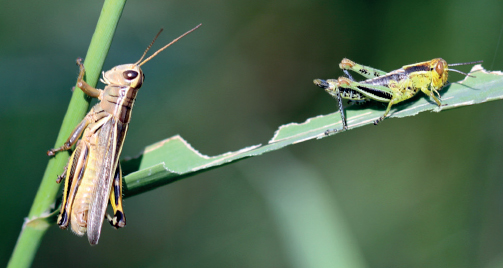
Adult and nymph of a grasshopper (Orthoptera). WHITNEY CRANSHAW
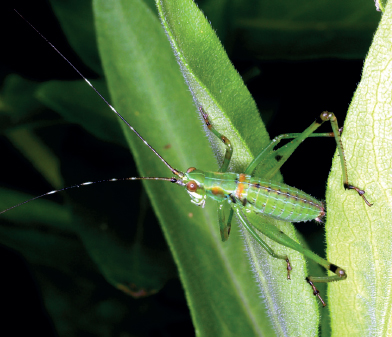
Katydid nymph (Orthoptera). JIM KALISCH, UNIVERSITY OF NEBRASKA
DERMAPTERA (EARWIGS)
Most features of immature and adult earwigs are similar. The forceps-like cerci on the tip of the abdomen and the wing pads increase in size as the insects mature.
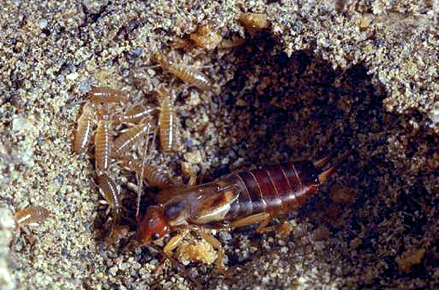
Adult earwig tending young (Dermaptera). KEN GRAY COLLECTIONS, OREGON STATE UNIVERSITY
MANTODEA (MANTIDS)
Mantids are recognized by their raptorial (grasping) front legs. Most external features of immature and adult mantids are similar except for the wings. As mantids develop, the wing pads become increasingly prominent, with the wings becoming fully developed and functional only in the adult stage.
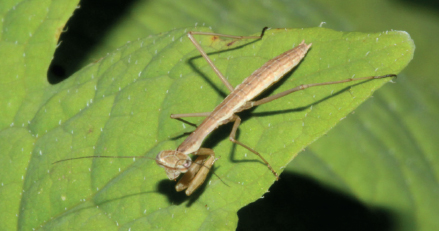
Nymph of a Carolina mantid (Mantodea). DAVID SHETLAR
BLATTODEA (COCKROACHES AND TERMITES)
Most external features of immature and adult cockroaches are similar except for the wings. As cockroaches develop, the wing pads become increasingly prominent, with the wings becoming fully developed and functional only in the adult stage.
Features of almost all immature and adult termites are similar, differing only in size. However, termites are social species and metamorphosis patterns are more flexible, allowing the production of various castes (e.g., workers, soldiers, reproductives) as colony needs determine. Reproductive forms possess large, functional wings in the adult stage and distinct wing buds in the early stages of development. Workers and soldiers are blind and not or only lightly pigmented. Winged reproductives have eyes and are often black or brown.
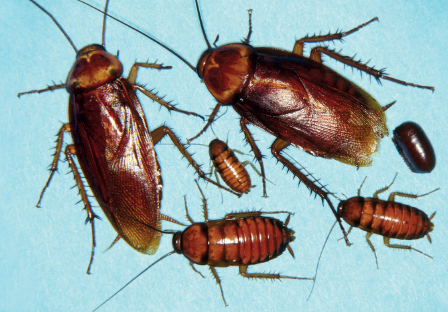
Life stages of an American cockroach (Blattodea). JIM KALISCH, UNIVERSITY OF NEBRASKA
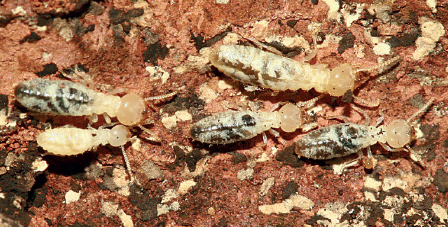
Nymphs of subterranean termite (Blattodea) in different stages of development. DAVID SHETLAR
THYSANOPTERA (THRIPS)
Most immature thrips roughly resemble adults in general body form, and the first two nymphal instars often are found together with the adults on plants. However, immature thrips lack wings and often have different coloration. Late stages (instars 3 and 4) usually drop to the soil and undergo physical changes, such as development of wing pads, which make them progressively similar to the ultimate adult form.
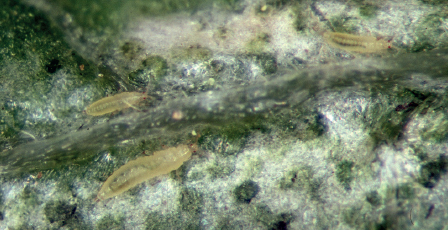
Nymphs of an onion thrips (Thysanoptera). WHITNEY CRANSHAW
HEMIPTERA (TRUE BUGS, APHIDS, PSYLLIDS, WHITEFLIES, SCALE INSECTS, CICADAS, LEAFHOPPERS, AND RELATIVES)
The order Hemiptera contains a large number of insects that all possess “piercing-sucking” mouthparts of similar design that allow them to pierce tissues (usually plant tissues) and suck fluids. All have a simple type of metamorphosis, and thus immature stages (nymphs) feed in a manner similar to the adults and share many other habits with them. Body form is generally similar, but nymphs lack the fully developed wings of the adults and are not sexually mature. Wing pads become increasingly prominent as the nymphs approach maturity.
In some families, however, there can be unusual forms. In whiteflies and psyllids, nymphs are quite flattened and look very different from the winged adults. This is particularly true in whiteflies where there is a special nonfeeding transition stage (sometimes referred to as a pupa) immediately preceding the adult. The first stage following egg hatch among scale insects, known as the crawler, is highly mobile and little resembles the more sedentary later stages that produce a waxy cover. Similarly, the nymphs of cicadas are specialized for life belowground, whereas adults are winged and look substantially different.
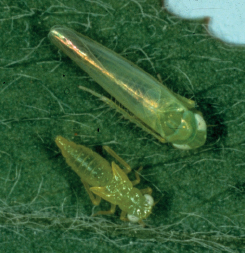
Adult and nymph of a potato leafhopper (Hemiptera). TED RADCLIFFE, UNIVERSITY OF MINNESOTA
ODONATA (DAMSELFLIES AND DRAGONFLIES)
Immature stages of dragonflies and damselflies develop in water and will not be encountered in a yard/garden setting, except sites with permanent water features. Their appearance is much different from their ultimate adult form, being wingless, often much more squat in body form, and possessing a unique modification of the mouthparts: an extensible “lower jaw” (labium) that is used to help capture insects and other prey. When full grown, the nymphs migrate to the edges of ponds or onto emergent vegetation, rocks, or other surfaces then molt to the adult stage.
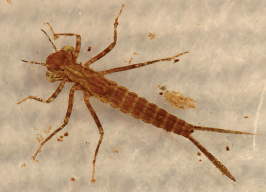
Damselfly nymph (Odonata). TOM MURRAY
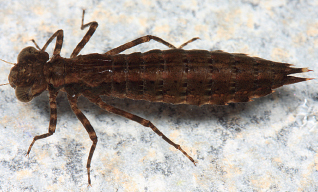
Dragonfly nymph (Odonata). TOM MURRAY
COLLEMBOLA (SPRINGTAILS)
All stages of springtails have similar external features and differ only in size. Unlike insects, springtails will continue to molt after they have reached the adult stage.
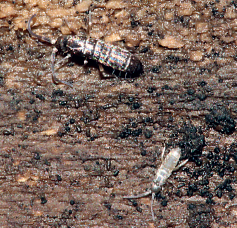
Adult and immature springtail. DAVID SHETLAR
ACARI (MITES AND TICKS)
Following egg hatch, all mites (except eriophyid mites) and ticks are minute and six-legged, a stage known as a larva. After the first molt they transform into eight-legged immature stages (nymphs) and possess the general body form of the adult for the remainder of their development. Among spider mites there are two additional molts as they transform through the protonymph and deutonymph, ultimately reaching the adult form. Other mites may have an additional nymphal stage (tritonymph). Special inactive “resting stages” may occur with these groups of mites.
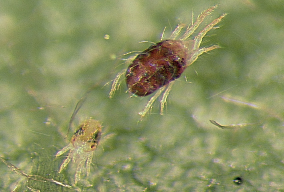
Larva and adult of a European red mite. DAVID SHETLAR
An unusual mite family is the eriophyid mites. These are minute, with an elongate, carrot-shaped form, and they possess only two pairs of forward-facing legs in all life stages.
DIPLOPODA (MILLIPEDES)
After egg hatch, the first instar of a millipede usually remains where the eggs were laid, and many have only three pairs of legs at this time. Subsequently, as they develop, millipedes go through many molting episodes, and during the early instars, they will add segments (with pairs of legs) following a molt. In addition to having more body segments and legs, older millipedes tend to darken in color.
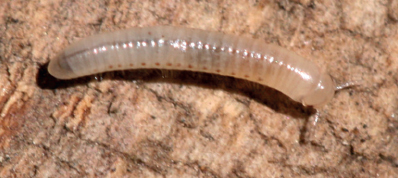
Immature julid millipede. WHITNEY CRANSHAW
CHILOPODA (CENTIPEDES)
Stone centipedes (order Lithobiomorpha) and house centipedes (order Scutigeromorpha) emerging from eggs (first instar) possess as few as 14 legs but add pairs in the next instars until they possess their full complement of 30 legs (15 pairs). Soil centipedes (order Geophilomorpha) and bark centipedes (order Scolopendromorpha) have their full complement of legs and segments at birth.
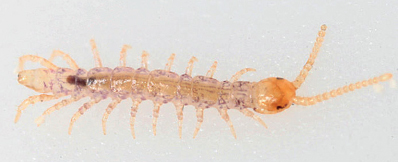
Immature stone centipede. TOM MURRAY
TERRESTRIAL ISOPODS (PILLBUGS AND SOWBUGS)
Adult pillbugs and sowbugs retain their eggs in a body pouch (marsupium). After the eggs hatch the immature forms disperse and within the first day they molt, at which time they gain an additional segment in the thoracic area. A couple of weeks later a second molt occurs and the seventh pair of legs develop. After this point they will periodically molt to larger sizes but have the same body form. Unlike other arthropods found in yards and gardens, pillbugs and sowbugs molt in two events each time, first shedding the exoskeleton of the back half, followed by that of the front.
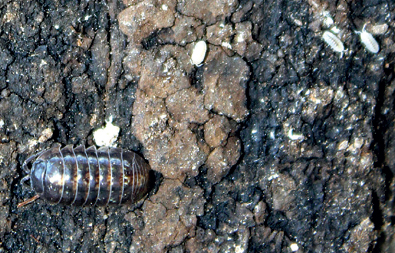
Adult and immature pillbugs. WHITNEY CRANSHAW
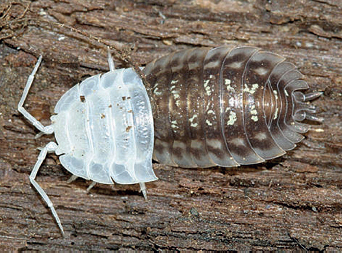
Sowbug in process of molting. TOM MURRAY
EXCRETED AND SECRETED PRODUCTS USEFUL IN DIAGNOSING GARDEN ARTHROPODS AND SLUGS
HONEYDEW This is a sticky, largely sugary liquid excreted by certain insects that feed on the phloem of plants. It is produced by certain insects in the order Hemiptera, notably aphids, soft scales, whiteflies, mealybugs, and some leafhoppers. Because of its high sugar content, honeydew is highly attractive to ants, wasps, bees, flies, and other insects. On surfaces where honeydew persists for long periods, it supports the growth of sooty molds, dark-colored fungi that may be seen on leaves, branches, and soil surfaces under plants that are supporting high populations of a honeydew-producing insect.
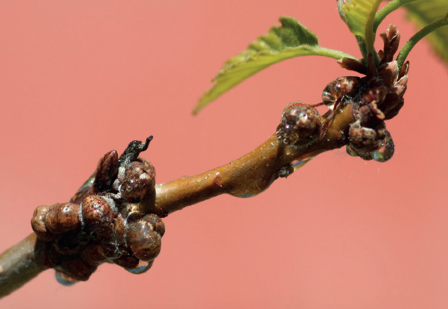
Honeydew being excreted by soft scales. WHITNEY CRANSHAW
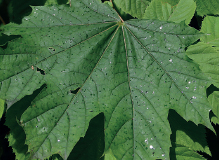
Droplets of honeydew on a leaf. DAVID SHETLAR
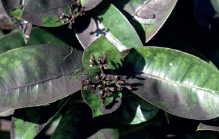
Sooty mold growing on a leaf surface that was covered with honeydew. DAVID SHETLAR
TAR SPOTS Dark fecal spots on foliage are associated with many plant-feeding insects that suck sap from the mesophyll (leaf tissues) of plants. These include thrips, lace bugs, some leafhoppers, plant bugs, and spider mites. Because of the nature of the feeding, there is usually associated leaf spotting (white, yellow, or brown spots). The size of the tar spots is related to the size of the insects.
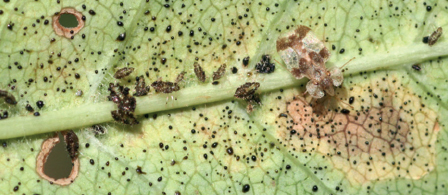
Tar spot excrement produced by lace bugs. WHITNEY CRANSHAW
Spotting is also produced by most moths shortly after they emerge from the pupal stage. It is usually pale brown or reddish brown and is known as meconium. Syrphid flies, a common family of aphid predators, also leave dark smears of excrement on plants.
FRASS The solid excrement produced by insects that feed on solid foods is known as frass. Texture and consistency depend largely on diet; insects feeding on high-moisture foods produce soft and watery frass, whereas those feeding on dried wood or grain produce granular frass. In some species the frass may have a highly characteristic pattern or texture and can be a useful identification aid.
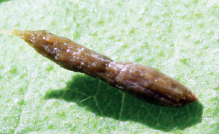
Excrement (frass) produced by a grasshopper. WHITNEY CRANSHAW
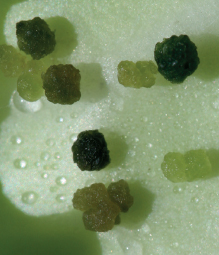
Excrement (frass) produced by cabbageworms. WHITNEY CRANSHAW
SILK The silk found around plants is most characteristic of caterpillars such as leafrollers, tent caterpillars, and webworms that use silk to create shelters and tie foliage together. The webspinning sawflies also construct shelters of silk. Silk, formed into a cocoon, also surrounds the pupal stage of many moth larvae, sawflies, lacewings, and other insects.
Most spider mites produce visible silk, particularly when their populations are high. Spiders use silk for many purposes. Most obvious are the webs some species use to snare prey. Other spiders use silk to form a “retreat” in which they hide when not foraging for prey. Also, almost all spiders use silk to cover egg masses.
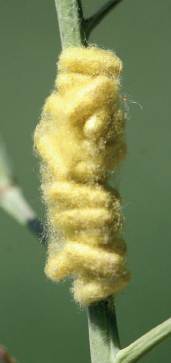
Silk producing a cocoon that covers the pupae of a parasitoid wasp. WHITNEY CRANSHAW
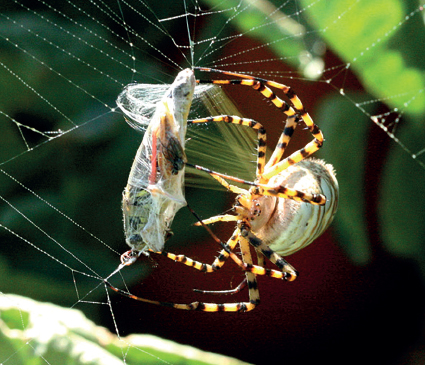
Silk being used by spider to bind prey. WHITNEY CRANSHAW
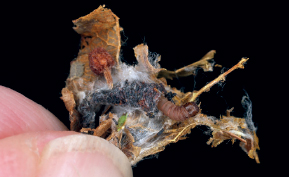
Silk used as a shelter for a leaf-feeding caterpillar. JIM KALISCH, UNIVERSITY OF NEBRASKA
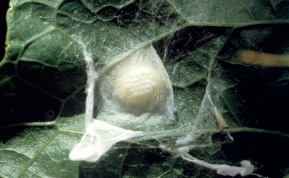
Silk used to cover spider egg mass. The top cover of silk has been peeled away in this image. WHITNEY CRANSHAW
WAX Many bees secrete wax from specialized glands to line or form cells used to rear young and store fluids. On plants, waxy material may be present as excreted products of some sap-feeding insects, particularly psyllids. This excreta may take the form of small pellets or waxy threads.
Wax may be secreted to cover the body of the “woolly” aphids, mealybugs, planthoppers, some scale insects, and psyllids. It can often be quite conspicuous when produced as egg sacs by mealybugs and soft scales.
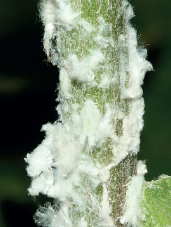
Wax covering bodies of planthoppers. DAVID SHETLAR
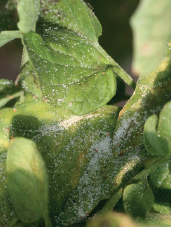
Wax pellets excreted by potato/tomato psyllid. WHITNEY CRANSHAW
MUCOUS TRAILS Slugs and snails produce a mucous covering that appears as a “slime trail” on surfaces they contact. It disappears rapidly with drying and is best observed early in the morning or in humid sites.
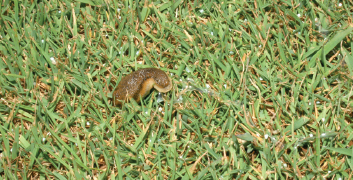
Mucous “slime trails” produced by a slug. DAVID SHETLAR
BODY PARTS USEFUL IN DIAGNOSING GARDEN ARTHROPODS
EXUVIAE (CAST SKINS) All arthropods shed their exoskeleton several times in the process of developing. Insects with chewing mouthparts usually consume the remnants of the cast-off exoskeleton (exuviae), shortly after molting. Insects with sucking mouthparts, such as aphids, leafhoppers or plant bugs, and spider mites, cannot consume the old cast skin, which may subsequently persist and be useful as a diagnostic sign.
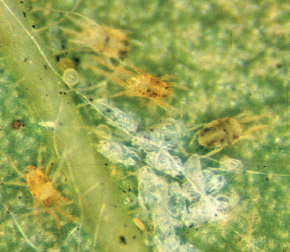
Spider mites and discarded exuviae. WHITNEY CRANSHAW
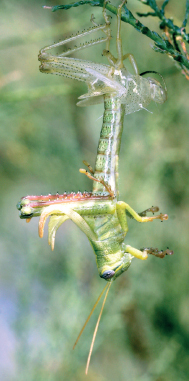
Grasshopper in the process of molting, leaving behind remnants of the old exoskeleton (exuviae). WHITNEY CRANSHAW
SCALE COVER The waxy cover of a scale insect is a shield that incorporates first- and second-instar exuviae; it is usually distinctive enough in shape and coloration to distinguish species. Furthermore, a scale covering may persist on a plant for a long time after the insect underneath has died, ultimately weathering and flaking off. The scale cover can also identify the stage of the insect, as the covering often appears as a series of rings, each produced following a molt.

Covers of an oystershell scale insect. DAVID SHETLAR
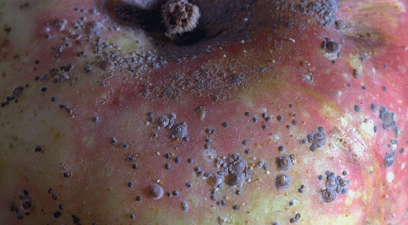
Covers of San Jose scales on apple fruit. KEN GRAY COLLECTION, OREGON STATE UNIVERSITY
EGGSHELLS Following egg hatch, many insects with chewing mouthparts consume the discarded eggshells. However, spider mites and insects with mouthparts designed to suck fluids leave the old eggshells intact. These may persist on foliage for a considerable period. Even when the insects or spider mites are no longer present, the old eggshells can be useful for diagnosis.
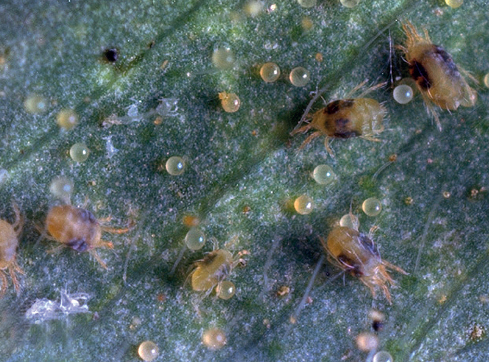
Spider mites and eggs. After egg hatch the eggshells remain intact. KEN GRAY COLLECTION, OREGON STATE UNIVERSITY
COMMON TYPES OF PLANT INJURIES CAUSED BY INSECTS
BRONZING/RUSSETING A generalized bronzing or graying of leaf and needle surfaces results from sustained feeding by large numbers of spider mites or rust mites. Such bronzing can start out as white or yellow stippling (see below) that turns brown with age. Often there is an associated thickening or increased leatheriness of the leaf or fruit surface. When such injury occurs on fruit, it is often termed russeting, and affected fruit may also show some slight scarring.
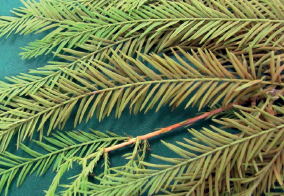
Leaf bronzing produced by rust mites on baldcypress. LORRAINE GRANEY, BARTLETT TREE EXPERTS, BUGWOOD.ORG
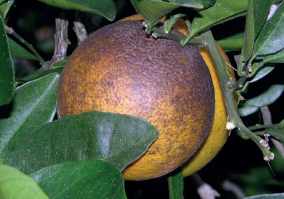
Russeting of citrus fruit by citrus rust mite. DON FERRIN, LOUISIANA STATE UNIVERSITY AGRICULTURAL CENTER, BUGWOOD.ORG
CATFACING OF FRUIT Distortion of the normal shape of fruit can result from a wide range of injuries to young fruit. Insects with sucking mouthparts, notably plant bugs and stink bugs, kill areas around the feeding site, resulting in deep dimples as the fruit expands. Smaller dimpling may result from egg-laying wounds or chewing injuries of adult weevils. Surface feeding on expanding fruit by caterpillars (fruitworms, leafrollers) typically results in large sunken areas, often with a scabby texture. Collectively these types of fruit distortions induced by insects are known as catfacing injuries.
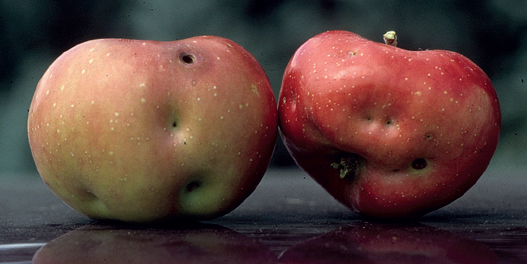
Catfacing injury of apple produced by plant bug feeding on young fruit. WHITNEY CRANSHAW
DEFOLIATION Strictly, defoliation relates to any leaf loss; however, it can be effected in many different ways. Most commonly it is caused by chewing insects that remove sections of tissue from individual leaves. Entire leaves may be consumed in this manner or leaves may subsequently drop (abscise) in response to injury. Defoliating insects that chew leaves include caterpillars, adults and larvae of many beetles, sawfly larvae, grasshoppers, earwigs, and leafcutting ants. Some insects defoliate plants in a characteristic manner and produce injuries described in such terms as notching, shotholing, skeletonizing, and windowpaning.
Leaves may also drop prematurely in response to various stresses including drought and nutrient deficiencies. High populations of spider mites and sap-sucking insects (aphids, leafhoppers, scales) may also induce premature leaf drop.
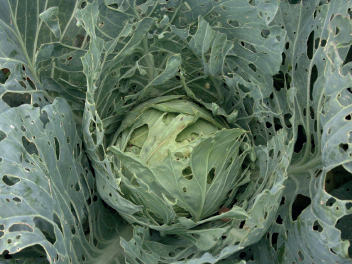
Defoliation of cabbage by imported cabbageworms. WHITNEY CRANSHAW
FLAGGING Wilting of leaves that remain attached results when water movement has been prevented from reaching the leaf tissues. This can be caused by various pathogens that girdle twigs, such as fire blight, or those that restrict water movement by plugging the xylem, such as Dutch elm disease. However, many insects can produce flagging by chewing twigs. Twig girdlers, certain grasshoppers, and European hornets are examples of insects that may chew on the outside of bark. Tip moths cause dieback of twigs, and other twig-boring caterpillars cause similar injuries to deciduous trees and shrubs. Flagging may occur on just the terminal growth of conifers, as occurs with white pine weevil.
A less common cause of flagging is wounding produced during egg-laying. These oviposition injuries are most prominent with cicadas, whose wounds often cause twigs to break.
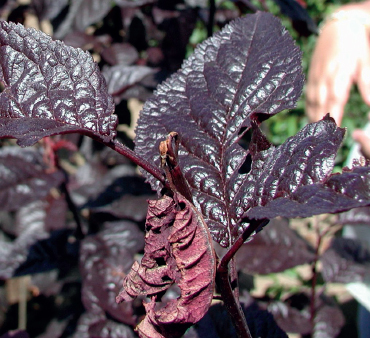
Twig flagging of plum due to tunneling by larva of peach twig borer. ROBIN ROSETTA, OREGON STATE UNIVERSITY
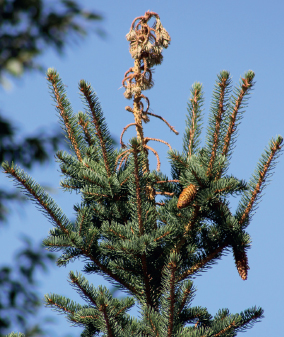
Flagging of terminal growth of spruce due to injury by white pine weevil. WHITNEY CRANSHAW
GALL PRODUCTION Many insects, mites, and some plant pathogens can cause plants to produce abnormal plant growths known as galls. Galls can occur on leaves, stems, flowers, branches, and roots of plants and are often of distinctive form.
Insect- and mite-induced galls are generally called open or closed galls. Open galls are formed by insects with sucking mouthparts, gall midges, and mites. Such galls have a natural opening that has the edges tightly held together until the insects or mites finish their development. At this time, the tissues shrink back and provide an opening for the insects or mites to escape. Closed galls completely surround the developing insect. These are formed by larvae of beetles, caterpillars, and wasps that have chewing mouthparts as larvae or adults, allowing them to chew a hole through the gall tissues allowing escape.
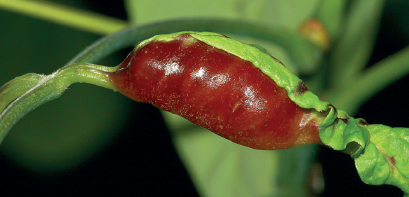
Open form gall produced by a gall midge. DAVID SHETLAR
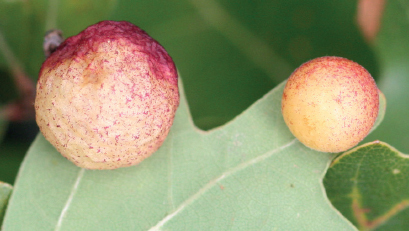
Closed galls, produced by a gall wasp. DAVID SHETLAR
LEAF CUPPING AND CURLING Leaves may cup in response to removal of tissue or to feeding by sucking insects during leaf expansion. This symptom is most characteristic of feeding injuries produced by certain thrips, plant bugs, aphids, and psyllids. (Other causes of leaf cupping include exposure to some herbicides and cold injury.) Feeding by some insects, notably aphids, can cause new leaves to tightly curl.
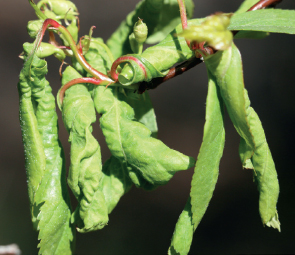
Leaf curls produced by aphids. WHITNEY CRANSHAW
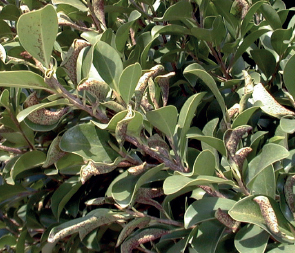
Leaf curls produced by Cuban laurel thrips. DAVID SHETLAR
LEAF FOLDING, ROLLING, AND TYING Several species of caterpillars fold over the margins of leaves and feed from within the fold. Affected leaves are held shut by tabs of silk. There are also many species of caterpillars that roll up leaves and feed within the protection of these shelters. Additional species of caterpillars tie two leaves together with silk and feed between the two layers.
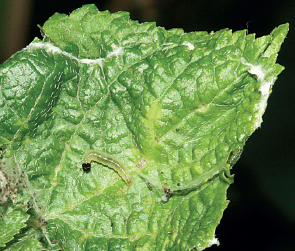
Hydrangea leaftier larva exposed from shelter of tied terminal leaves. DAVID SHETLAR

Grape leaffolder larvae exposed in shelter produced by rolled leaf edge. DAVID SHETLAR
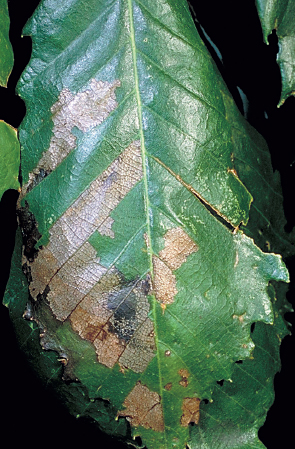
Two oak leaves tied together to form shelter for a leaf-tying caterpillar of oak. DAVID SHETLAR
MINING OF LEAVES AND NEEDLES Certain insects, known as leafminers and needleminers, develop by tunneling between the upper and lower surfaces of leaves and needles, respectively. External evidence of these insects appears as discolored tunnels, often in a blotch or serpentine form. Leafminers can be separated from other causes of leaf spotting (e.g., fungi, bacteria, chemical injuries) by the leaf surfaces being easily separated and by the presence of the larvae and/or excrement. Leaf- and needleminers include larvae of various caterpillars, sawflies, flies, and beetles.
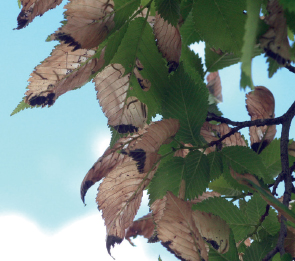
Blotch-form leafmines produced by elm leafminer larvae. WHITNEY CRANSHAW
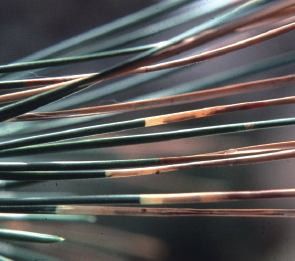
Larvae of a needleminer in ponderosa pine needles. ROBERT STEVENS, USDA FOREST SERVICE
NOTCHING OF LEAF MARGINS Chewing along the edge of leaves is characteristic of many insects such as certain adult weevils, caterpillars, sawflies, earwigs, and grasshoppers. Only a few limit feeding to the margin, however, and some make regular, angular cuts, which is particularly common among adult root weevils, such as the black vine weevil. Notching is also used to describe the semicircular cuts characteristic of leafcutter bees and leafcutting ants.
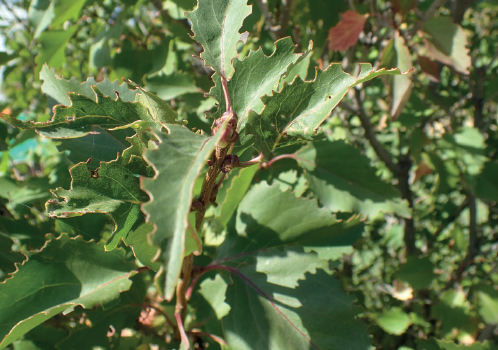
Angular leaf notching produced by root weevils. WHITNEY CRANSHAW
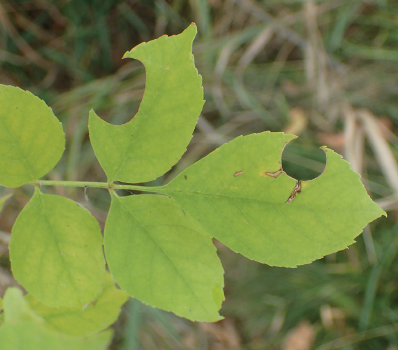
Smooth, semicircular leaf-edge cuts made by leafcutter bees. WHITNEY CRANSHAW
OVIPOSITION WOUNDING Some insects damage plants in the process of laying eggs (oviposition). Small puncture wounds in leaves or needles are characteristic of sawflies. Adult leafmining flies also puncture leaves both when laying eggs and to feed on fluids produced by these wounds. Less conspicuously, eggs are inserted into leaf tissues by several other insects such as leafhoppers, plant bugs, lace bugs, and thrips.
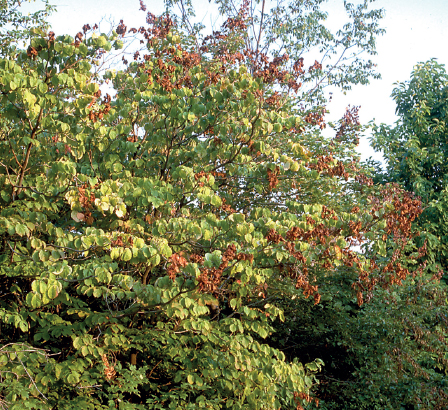
Leaf flagging resulting from twigs breaking from oviposition wounds of cicadas. DAVID SHETLAR
Egg-laying scars also occur on other parts of the plant. Twig scars are produced when cicadas, treehoppers, and certain leafhoppers insert eggs into young twigs. Seriously damaged twigs may break, producing flagging. Fruit may be damaged when flower thrips or fruit flies insert eggs into developing fruit or when weevils chew the fruit surface prior to egg-laying.
PANSY SPOTTING Diffuse cloudy areas on the surface of maturing fruit or leaves can result from feeding injuries by stink bugs feeding on maturing fruit. Areas around egg punctures of thrips can also result in halo-shaped pansy spots on seedpods and fruit surfaces.
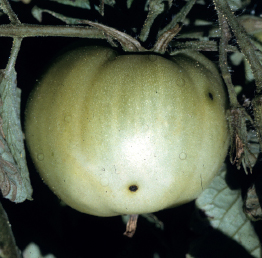
Dark scar from egg laying by thrips surrounded by pale area (pansy spotting). WHITNEY CRANSHAW
REDDENING Leaf reddening can be a plant response to saliva introduced by certain aphids, scales, and spider mites. This reaction is often plant specific; i.e., it can occur on some species or cultivars but not on others. Color changes can also occur in evergreens when branches die from injuries produced by bark beetles. For example, certain bark beetles that attack conifers can cause foliage to turn reddish brown. The process of color change from the original green is often called “fading.”
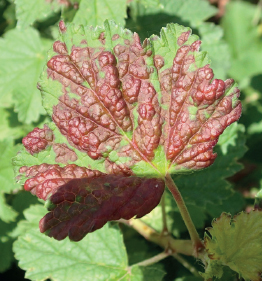
Red color change induced by feeding of currant aphid. WHITNEY CRANSHAW
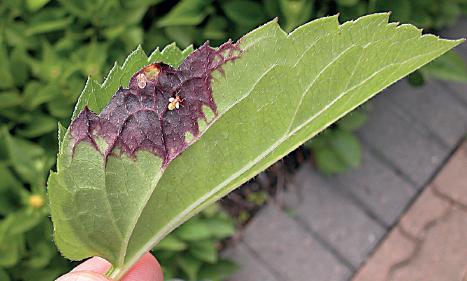
Red area developing around feeding site of rudbeckia psyllid. DAVID SHETLAR
SCARRING Scarring of leaves and flowers can result from the reaction of a plant to feeding by many insects that suck sap from the mesophyll and destroy cells as they feed. Scarring injuries are most commonly associated with thrips and typically appear silvery, often with small droplets of dark feces. Scarring injuries to emergent growth often result in tattered and distorted foliage.
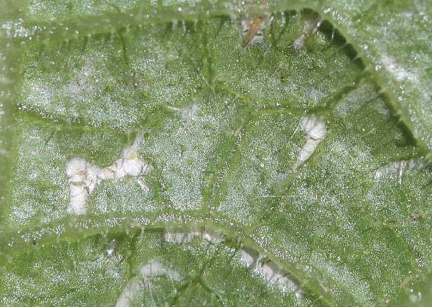
Leaf scars produced by thrips. WHITNEY CRANSHAW
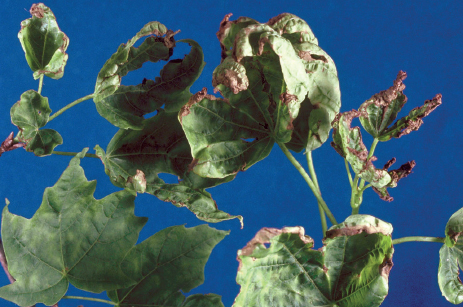
Leaf tattering resulting from thrips scarring wounds made while feeding on emergent leaves. RONALD S. KELLEY, VERMONT DEPARTMENT OF FORESTS, PARKS AND RECREATION, BUGWOOD.ORG
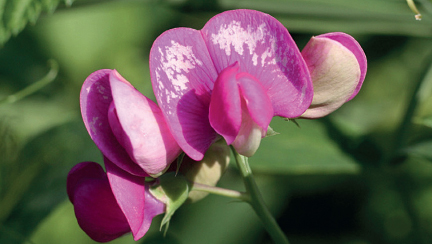
Petal scars resulting from feeding injuries of thrips. WHITNEY CRANSHAW
SHOTHOLING Shothole injuries are small, generally round holes cut into leaves. One leaf surface is usually left intact, but it typically dries, allowing a hole to form through the leaf. Insects that produce shotholes include adult flea beetles, young stages of some caterpillars, and some young sawfly larvae. Large holes are typical of feeding by some adult leaf beetles and older sawflies.
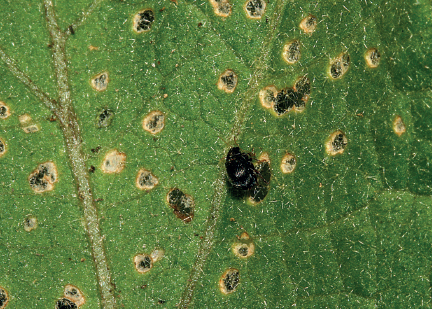
Shotholes produced by a flea beetle. DAVID SHETLAR
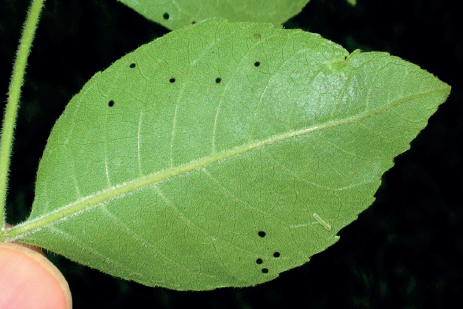
Shotholes produced by young larva of a sawfly. JIM KALISCH, UNIVERSITY OF NEBRASKA
Leaf tissues may drop out in response to the puncture wounds some insects make when laying eggs. Damage of tissues by plant-bug feeding sometimes results in irregular areas that later die and drop. Some fungi also cause shotholes to form on foliage in areas where infected tissue drops out. The term shothole is also applied to exit holes produced by various small wood-boring bark beetles and weevils.
SKELETONIZING This involves a pattern of selective feeding on leaves in which chewing insects avoid main veins and usually one leaf surface. This kind of injury is characteristic of insects such as Japanese beetle, larvae of certain leaf beetles, slug sawflies, and caterpillars known as skeletonizers. This feeding habit may be restricted to younger stages of caterpillars that later feed more generally on plants. The leaf surface that is skeletonized (upper vs. lower) can also be characteristic of an insect’s feeding habit.
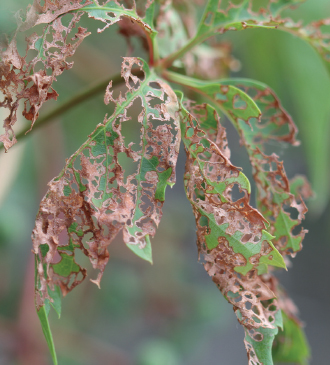
Virginia creeper leaves skeletonized by Japanese beetles. WHITNEY CRANSHAW
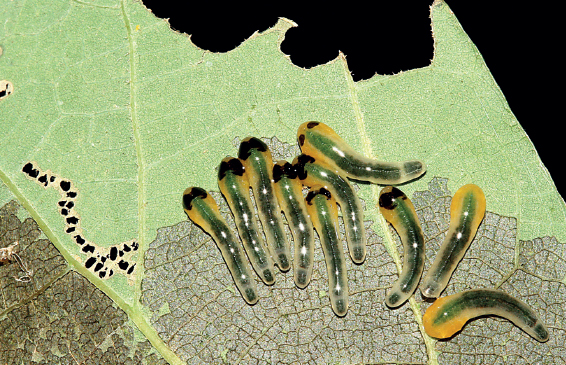
Slug sawflies skeletonizing leaf surface of oak. DAVID SHETLAR
STIPPLING Whitish or yellowish spots, known as stippling, are produced when insects or mites remove cell sap from leaves. Mesophyll-feeding insects such as certain leafhoppers, plant bugs, and lace bugs characteristically produce very visible stippling. The affected leaf surface can differ between species, and often there is some associated dark fecal spotting around the injury. Smaller wounds result from feeding by thrips and spider mites. When damage is extensive, injuries may coalesce to produce silvery patches or a bronzing color change on the leaves.
Stippling is also used to describe the small punctures produced by some insects with their ovipositor. Many types of flies in particular use their ovipositor not only to insert eggs but also to puncture plant cells so fluids will be released, on which the flies feed. This type of injury may result in small sunken areas.
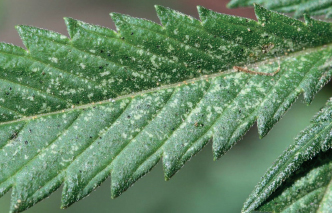
Stippling injuries produced by spider mites. WHITNEY CRANSHAW
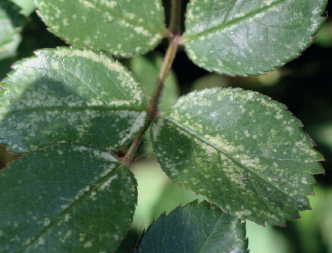
Stippling injuries produced by rose leafhopper. WHITNEY CRANSHAW
STREAKING A change in color (yellow, red, white) in a streak pattern on leaves and/or stems can result from feeding by some aphids, scales, and mealybugs, particularly those that develop on grasses or other plants with parallel leaf veins.
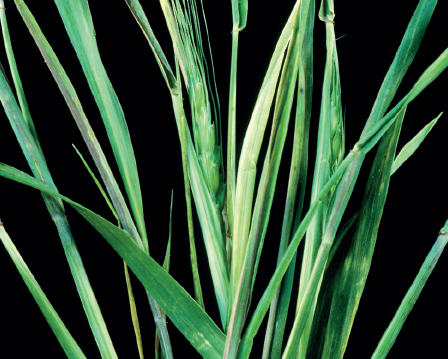
Streaking symptoms of leaves resulting from injury by Russian wheat aphid. JIM KALISCH, UNIVERSITY OF NEBRASKA
WINDOWPANING This injury is associated with chewing insects that leave a surface (usually the upper surface) of foliage intact, producing a translucent hole covered by a thin fill of leaf epidermis. Windowpaning is typical of many kinds of young caterpillars; some slug sawflies also produce it. This type of injury intergrades with shotholing (see above).
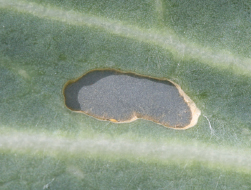
Windowpaning symptom produced by a young cabbageworm larva. WHITNEY CRANSHAW
YELLOWING Yellowing (chlorosis) is a generalized plant response to a wide variety of stresses, including nutrient deficiencies, drought, and infection by certain pathogens. It can also be induced by heavy infestations of certain sap-sucking insects such as aphids, soft scales, and psyllids. Yellowing may also result from feeding by spider mites and eriophyid mites (rust mites).
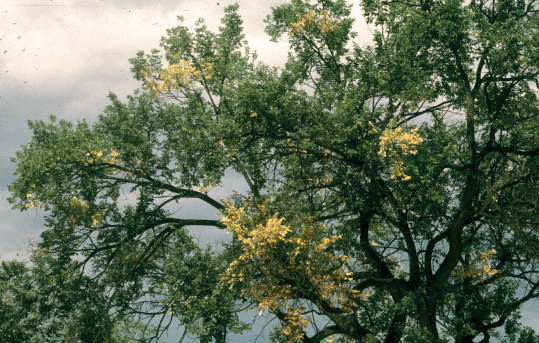
Premature yellowing of elm branches heavily infested with European elm scale. WHITNEY CRANSHAW
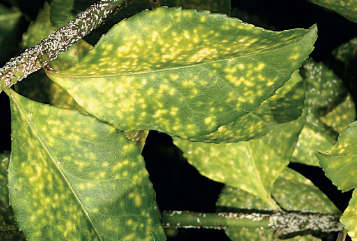
Yellow leaf spotting produced by feeding injury of euonymus scale. DAVID SHETLAR
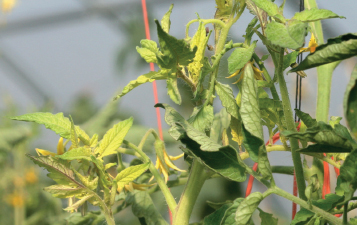
Leaf yellowing of tomato resulting from effects of potato/tomato psyllid feeding. WHITNEY CRANSHAW
PLANT PATHOGENS TRANSMITTED BY INSECTS AND MITES
Many arthropods, particularly insects and some eriophyid mites, are involved in spreading plant diseases, especially those species that act as vectors, providing the sole means of disease spread. Other species may have a more casual relationship with the pathogen, moving it around as an external contaminant. In a few cases the relationship between the plant pathogen and its arthropod vector benefits the arthropod, a situation known as a mutualistic relationship. (Certain bark beetles and horntails have mutualistic relationships with plant pathogenic fungi.) Some of the plant diseases that most often involve pathogen transmission by arthropods in North America are given.
PLANT DISEASE |
ARTHROPOD GROUP |
VIRUSES |
|
Many viral diseases of various classes, including cucumber mosaic, potato virus Y, potato leafroll |
Aphids |
Beet curly top |
Leafhoppers |
Lettuce infectious yellows, tomato yellow leaf curl, many geminiviruses |
Whiteflies |
Tomato spotted wilt, impatiens necrotic spot, iris yellow spot (tospoviruses) |
Thrips |
Wheat streak mosaic, peach mosaic, rose rosette |
Eriophyid mites |
PHYTOPLASMAS |
|
Aster yellows, ash yellows, elm phloem necrosis |
Leafhoppers |
Pear decline |
Psyllids |
XYLEM-LIMITED BACTERIA |
|
Pierce’s disease of grape, bacterial leaf scorch |
Leafhoppers (sharpshooters) |
OTHER BACTERIA |
|
Citrus greening, zebra chip |
Psyllids |
Various soft-rotting bacteria |
Root maggots |
Bacterial wilt of cucurbits, Stewart’s wilt of corn |
Leaf beetles |
Cucurbit yellow vine disease |
Squash bug |
Many bacteria, as external contaminants |
Vinegar flies |
FUNGI |
|
Dutch elm disease, blue stain of conifers, thousand cankers, many others |
Bark beetles |
Ambrosia fungi, laurel wilt |
Ambrosia beetles |
White rots |
Horntails |
Oak wilt; many other fungi, as external contaminants |
Sap beetles |
Many fungi, as external contaminants |
Vinegar flies |
Many root-rotting fungi, as external contaminants |
Bulb mites |
Many root-rotting fungi, as external contaminants |
Fungus gnats |
NEMATODES |
|
Pine wilt |
Longhorned beetles (pine sawyers) |